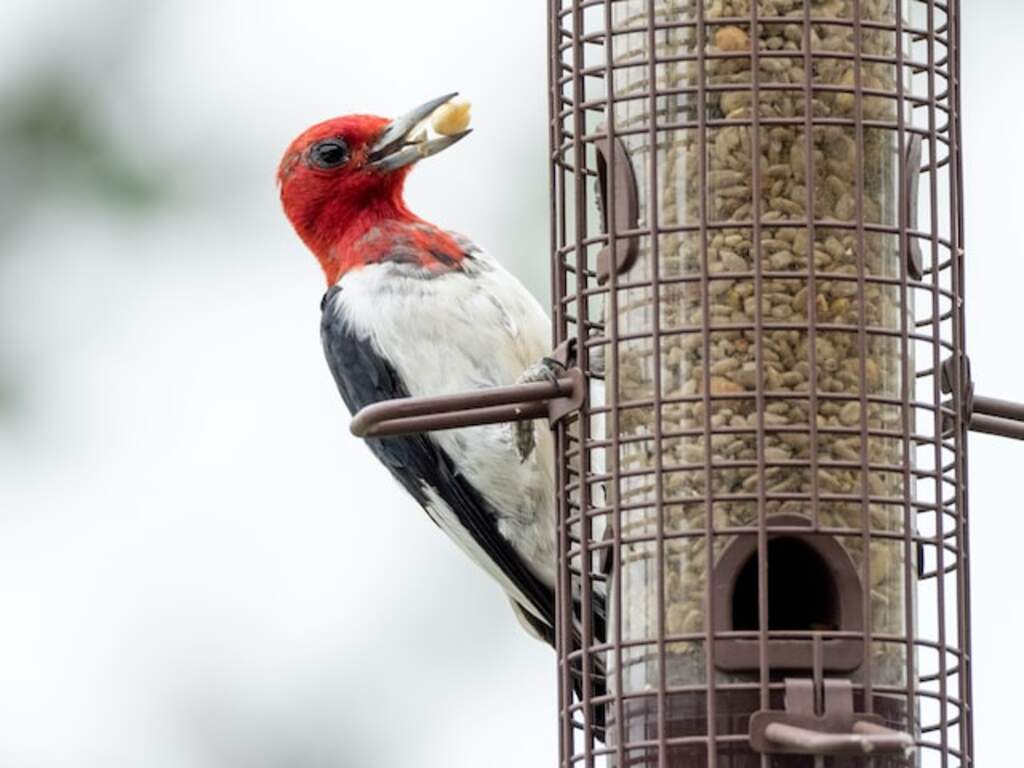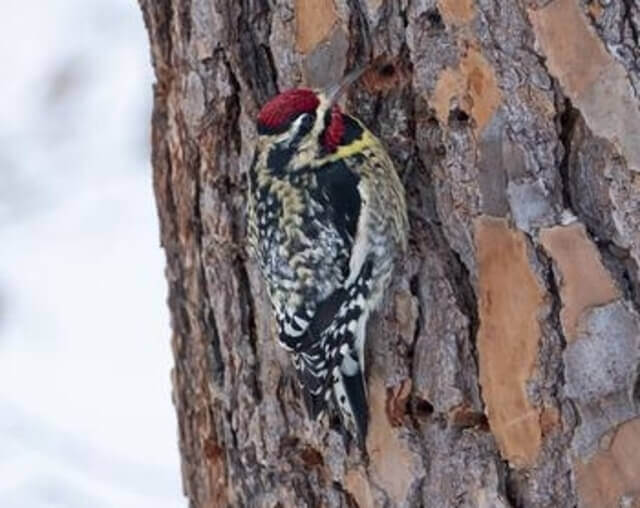Embark on a journey through Louisiana’s diverse habitats with our expert guide to the 12 types of woodpeckers! From the majestic Pileated Woodpecker to the elusive Red-headed Woodpecker, Louisiana’s forests, swamps, and urban areas provide a haven for these fascinating birds.
In this comprehensive guide, we’ll uncover the unique characteristics, habitats, and behaviors of each woodpecker species, offering valuable insights for bird enthusiasts and nature lovers alike.
Table of Contents [show]
Types of Woodpeckers in Louisiana
Red-bellied Woodpecker
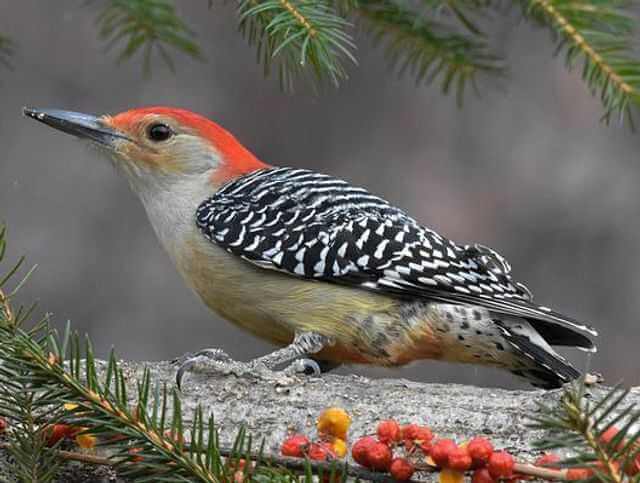
- Length: 9.5 in (24 cm)
- Weight: 2.0-3.2 oz. (56-90 g)
- Wingspan: 13.0-16.5 in (33-42 cm)
- Scientific Name: Melanerpes carolinus
- Frequency of Occurrence: 36.44% (Statistic by: eBird)
- Where To Find Them: The red-bellied woodpecker is a common sight in many parts of Louisiana, but they can be found in a few specific locations. Areas such as the Atchafalaya Basin and the Pearl River Delta are good spots to look for these birds, as they like to live near fresh water sources.
- How to Attract: Red-bellied Woodpeckers are a common visitor to many yards throughout the United States. These birds love to eat suet, and they especially enjoy suet blends that contain bark butter. To attract these woodpeckers to your yard, provide them with plenty of food sources, including nuts and seeds. You can also try using mealworms or sunflower chips as a food source for the birds.
Description: The red-bellied woodpecker is a small bird that can be found in most of North America. It ranges from southern Canada to central Mexico, and it can also be found in the Caribbean. The red-bellied woodpecker is a bird of the woods, and its distribution range reflects this. It prefers heavily forested areas, but it can also be found near open fields or in parks.
The red-bellied woodpecker is an insectivore, and its diet consists mostly of insects. It especially likes to eat beetles, but it will also eat other insects. The red-bellied woodpecker nests in cavities in trees. It excavates a new cavity each year, and the cavity varies in size depending on the tree species that the woodpecker is using as its nest site.
Handpicked Related Content: How to Attract Red-bellied Woodpeckers to your Yard?
Downy Woodpecker
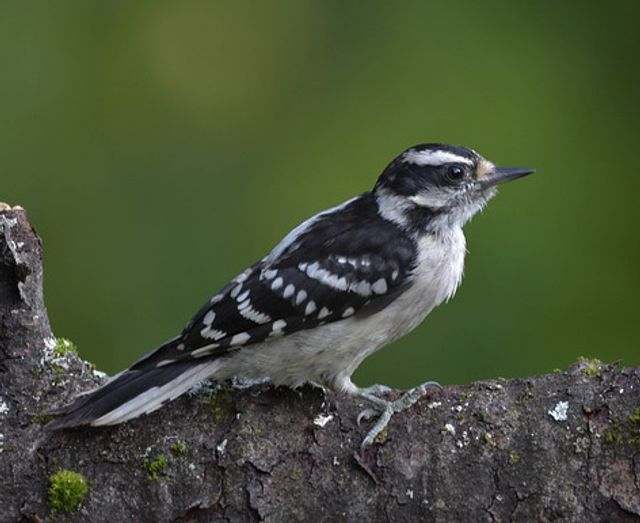
- Length: 5.5-6.7 in (14-17 cm)
- Weight: 0.7-1.0 oz. (21-28 g)
- Wingspan: 9.8-11.8 in (25-30 cm)
- Scientific Name: Picoides pubescens
- Frequency of Occurrence: 29.65%
- Where To Find Them: The Downy Woodpecker can be found in the following locations in Louisiana: Shreveport, Bossier City, Monroe, Alexandria, and Brookhaven.
- How to Attract: Black-oil sunflower seeds are a good choice for attracting red-bellied woodpeckers. They’re high in protein and fat, which the birds love, and they also contain a type of seed that’s hard to find elsewhere. Be sure to keep your feeder full though; these birds can get pretty hungry! Millet is another great option for bird feeders. It’s high in fiber and other nutrients, which the birds will appreciate, and it doesn’t spoil as quickly as some other types of seed.
Description: Downy woodpeckers are found throughout most of North America. They inhabit deciduous and mixed forests, as well as suburban areas. The distribution range includes the eastern seaboard from Maine to Florida, and the west coast from British Columbia to central California.
Downy woodpeckers prefer to forage in trees for insects, seeds and berries, but will also take bird feed from feeders. Downy woodpeckers usually build their nests in holes or cavities in trees but can also use old nests of other birds.
Handpicked Related Content: How to Attract Downy Woodpeckers to Your Yard? (Easy!)
Pileated Woodpecker
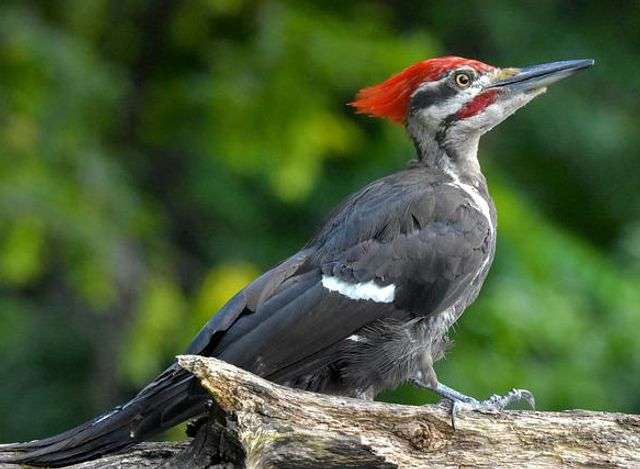
- Length: 15.8-19.3 in (40-49 cm)
- Weight: 8.8-12.3 oz. (250-350 g)
- Wingspan: 26.0-29.5 in (66-75 cm)
- Scientific Name: Dryocopus pileatus
- Frequency of Occurrence: 11.98%
- Where To Find Them: The pileated woodpecker is a large bird that can be found in several locations in Louisiana. They are most commonly found in the eastern part of the state, but they have been spotted as far west as Shreveport and as far north as Alexandria. They prefer wooded areas with lots of trees, but they are also known to frequent open fields and even suburban neighborhoods.
- How To Attract: There are many ways to attract a pileated woodpecker to your yard, but the key is to have plenty of food options. Black-oil sunflower seeds are a favorite of these large birds, so make sure you have a good supply on hand. Peanuts are another great option, and they love peanut butter too. If you can’t get your hands on any of those food items, consider using suet as bait. This type of bird feed will also provide some protein and other nutrients the pileated woodpecker needs.
Description: The Pileated Woodpecker is a large woodpecker that is found in the eastern United States and throughout much of Canada. The Pileated Woodpecker has a distribution range that ranges from southern New England to central Texas, and it can be found in both open and heavily forested areas.
The diet of the Pileated Woodpecker consists mainly of insects, but it will also eat seeds, berries, and nuts. The Pileated Woodpecker is an active woodpecker that likes to forage for food on the ground. It commonly nests in holes or cavities in trees, but it has also been known to nest on cliffs or ledges.
Handpicked Related Content: How to Attract Pileated Woodpeckers to your Yard (Fast)
Northern Flicker
- Length: 11.0-12.0 in (28-31 cm)
- Weight: 3.9-5.6 oz. (110-160 g)
- Wingspan: 16.5-20.0 in (42-51 cm)
- Scientific Name: Colaptes auratus
- Frequency of Occurrence: 11.84%
- Where To Find Them: The Northern Flicker is a common bird found in Louisiana. These birds can be found in many locations throughout the state, but some of their most popular spots include Breaux Bridge, Cajun Country, and the Acadiana region.
- How To Attract: You can attract these birds to your yard by providing them with a platform feeder with peanut hearts or black-oil sunflower seeds. You can also install a bird bath for them to use.
Description: The northern flicker is a small but colorful bird that can be found throughout the United States and parts of Canada. The northern flicker’s distribution range includes most of the central and eastern United States, as well as most of southern Canada. Northern flickers are found in a variety of habitats, including open country, woodlands, and urban areas.
Northern flickers eat insects, such as beetles, termites, ants, and other small invertebrates. They also eat fruits and seeds. Northern flickers excavate nest holes in dead or diseased tree trunks.
Handpicked Related Content: How to Attract Pileated Woodpeckers to your Yard (Fast)
Yellow-bellied Sapsucker
- Length: 7.1-8.7 in (18-22 cm)
- Weight: 1.5-1.9 oz. (43-55 g)
- Wingspan: 13.4-15.8 in (34-40 cm)
- Scientific Name: Sphyrapicus varius
- Frequency of Occurrence: 7.99%
- Where To Find Them: The Yellow-bellied Sapsucker is a bird that can be found throughout the state of Louisiana. The best locations to find them are in the Ouachita National Forest and in the Catahoula National Forest.
- How to Attract: If you’re looking to attract the yellow-bellied sapsucker to your yard, setting up a suet feeder is a great way to do it. This bird loves insects, and will come to your yard for a free meal of suet every time.The best way to set up a suet feeder is by hanging it from a tree or post in your yard. Another great way to attract the yellow-bellied sapsucker is by installing a bird bath filled with fresh water and some rocks. The birds will love soaking up the sun and taking a dip in your cool water!
Description: The yellow-bellied sapsucker is a small bird endemic to North America. It is found in the eastern United States and Canada, as well as in northern Mexico. The yellow-bellied sapsucker occupies a range of habitats from deciduous and mixed forests to coniferous forests.
It feeds mainly on sap from trees, but also consumes other insects and invertebrates. The yellow-bellied sapsucker nests in cavities in tree trunks or other vertical surfaces.
Handpicked Related Content: 16 Interesting Sapsucker Facts Revealed!
Red-headed Woodpecker
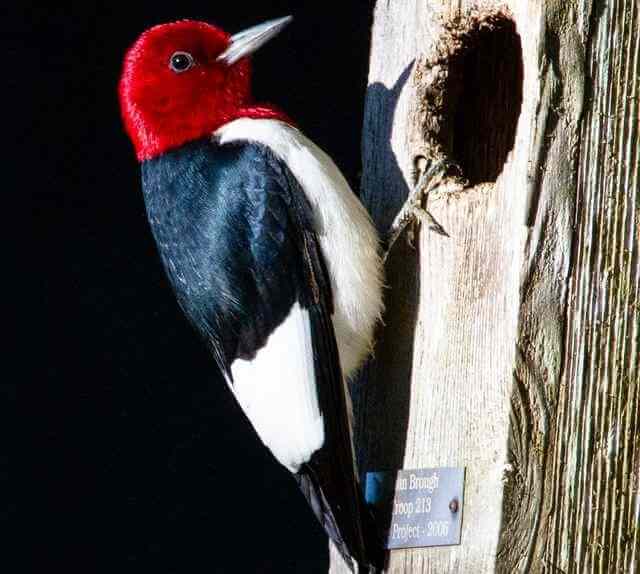
- Length: 7.5-9.1 in (19-23 cm)
- Weight: 2.0-3.2 oz. (56-91 g)
- Wingspan: 16.5 in (42 cm)
- Scientific Name: Melanerpes erythrocephalus
- Frequency of Occurrence: 6.37%
- Where To Find Them: It can be found in many different locations in Louisiana. Some of the places where you can find this bird are near Lake Charles, Baton Rouge, and Shreveport.
- How to Attract:Looking to attract red-headed woodpeckers to your yard? Here are a few tips to get them interested: Offer black-oil sunflower seeds as a food source. They will love the taste and the crunch of these nuts.Use peanut butter as another food source for birds. Spread a little on a tree and let them have at it! Hang suet feeders with peanut butter suet,, where red-headed woodpeckers like to hang out. This high-fat animal feed will tempt them even more. Create hiding spots for birds in your garden by planting tall plants that can provide cover, such as sumac or birch trees. Woodpeckers love to hide from predators, so providing some safety will encourage them to stay around your yard!
Description: The red-headed woodpecker is the most common woodpecker in the United States, and is found throughout most of the country. It ranges from southern Canada to central Florida, and is also found in parts of Mexico. The red-headed woodpecker prefers areas with lots of trees and insects, such as oak and maple forests, but will also use other types of habitats including urban areas.
The red-headed woodpecker feeds mainly on insects, but will also eat seeds and berries. They are mainly active during the morning and afternoon hours. They often build their nests in holes or cavities in trees. It typically excavates holes in trees or uses cavities in rocks to nest.
Handpicked Related Content: Interesting Red-Headed Woodpecker Facts (Explained)
Hairy Woodpecker

- Length: 7.1-10.2 in (18-26 cm)
- Weight: 1.4-3.4 oz. (40-95 g)
- Wingspan: 13.0-16.1 in (33-41 cm)
- Scientific Name: Picoides villosus
- Frequency of Occurrence: 2.74%
- Where To Find Them: The Hairy Woodpecker is a large woodpecker that can be found in a few locations in Louisiana. Their range includes the coast, the bayou country, and the rural areas near the Mississippi River.
- How To Attract: Hairy Woodpeckers are natural visitors to your yard, but how can you attract them? One way is to hang suet or peanut feeders in trees near a birdbath. Black oil sunflower seeds are also a good food for these birds.
Description: The Hairy Woodpecker is a common bird found throughout the eastern and central United States. The Hairy Woodpecker’s distribution range includes most of North America, from southern Canada to northern Mexico. The woodpecker can be found in a variety of habitats, including deciduous and coniferous forests, open fields, and commercial or residential areas.
The Hairy Woodpecker feeds on insects, especially beetles and caterpillars. It also consumes small fruits and berries. The woodpecker nests in holes or cavities in trees or other structures.
Red-cocked Woodpecker

- Length: 7.0–9.0″ in. (17.8-22.9 cm)
- Weight: 1.4–2.0 oz. (40–56 g)
- Wingspan: 13–16″ in. (34-41 cm)
- Scientific Name: Leuconotopicus borealis
- Frequency of Occurrence: 0.7895%
- Where To Find Them: In Louisiana, they can be found in the following locations: Acadia National Park, Oak Ridge Research Facility, Kisatchie National Forest, and Vermilionville Nature Preserve.
- How To Attract: Insect suet is a great way to attract them, as they love to eat insects. Black oil sunflower feeders also make great additions to your yard and offer plenty of food for these birds.
Description: The red-cockaded woodpecker is a common bird found throughout the eastern United States. Habitat The red-cockaded woodpecker inhabits forests, both deciduous and evergreen, but is most commonly seen in areas with lots of trees and large limbs.
Insects are the main food source for this bird and it will often search for insects in low lying vegetation or under bark. They also feed on seeds and berries. eggs, Young red-cockaded woodpeckers build their nests in holes or cavities in trees.
Red-naped Sapsucker
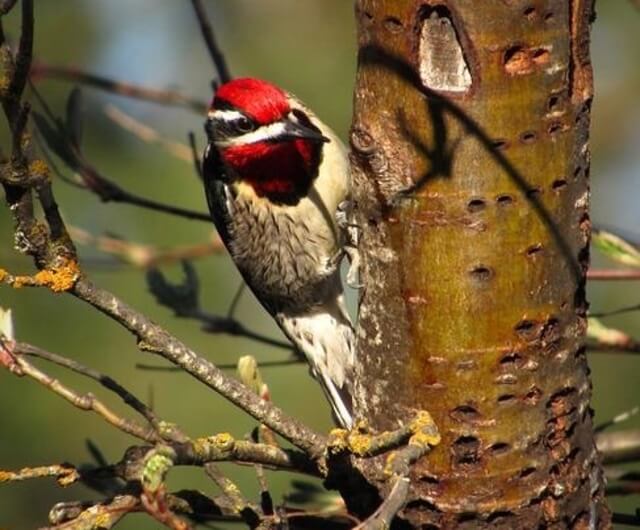
- Length: 7.1-8.7″ in (18-22 cm)
- Weight: 1.1-2.3 oz. (32-65 g)
- Wingspan: 15.7-17.3″ in (40-44 cm)
- Scientific Name: Sphyrapicus ruber
- Frequency of Occurrence: 0.0011%
- Where To Find Them: The red-naped sapsucker is a bird that can be found in a variety of locations throughout Louisiana. This particular bird is commonly found in the eastern part of the state, but has been known to be spotted as far west as Shreveport and Bossier City. Although they are not typically shy birds, they will usually avoid humans if possible.
- How To Attract: If you’re looking to attract a red-naped sapsucker to your yard, you’ll need to provide them with plenty of suet. This sturdy seed cake is the preferred food of these woodpeckers, and will give them a place to gather as well as plenty of food. You can also set up a bird bath filled with fresh water for the sapsuckers to drink from.
Description: The red-naped sapsucker is a common bird in the northeast. It ranges from southern Quebec and Ontario, down to Florida and Texas. This bird inhabits a variety of habitats including deciduous and coniferous forests, wetlands, agricultural areas, urban areas, and suburban gardens.
The sapsucker feeds on insects such as flies, beetles, moths, and caterpillars. It also eats sap from trees such as oaks and maples. The red-naped sapsucker is a cavity nester which means it builds its nest in an existing hole or crevice in a tree.
Ladder-backed Woodpecker
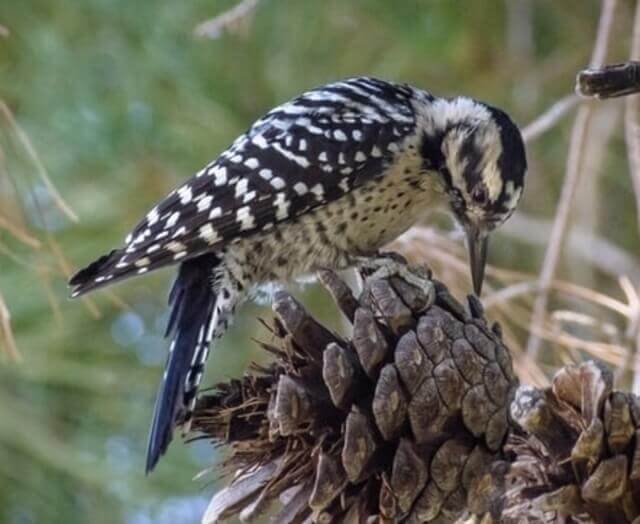
- Length: 6.3-7.1 in (16-18 cm)
- Weight: 0.7-1.7 oz (21-48 g)
- Wingspan: 13.0 in (33 cm)
- Scientific Name: Dryobates scalaris
- Frequency of Occurrence: 0.0004%
- Where To Find Them: In Louisiana, this species can be found in the following counties: Allen, Acadia, Avoyelles, Cameron, Catonsville, Iberville, Jefferson Davis, Orleans, St. Bernard.
- How to Attract: Try using peanut butter suet as bait. This will give the woodpecker something to peck at and will also provide a good source of energy for them. Place black oil sunflower seed feeders near trees where the ladder-backed woodpecker is known to live.
Description: The ladder-backed woodpecker is found in the southeastern United States and parts of Mexico. Its distribution range includes the following states: Alabama, Florida, Georgia, Louisiana, Mississippi, Tennessee, South Carolina, and Texas. The woodpecker can also be found in Arkansas and Kentucky. The ladder-backed woodpecker is a bird of the tropical rainforest biome.
It prefers to live in areas with plenty of trees and a flat surface for nesting. This species excavates its own nests out of dead trees using its strong beak. The ladder-backed woodpecker feeds mainly on insects and insect larvae. It eats mainly insects such as beetles, ants, bees, wasps, ants and slugs.
Williamson Sapsucker

- Length: 7.9-9.8″ in. (20-25 cm)
- Weight: 1.6-1.9 oz (44-55 g)
- Wingspan: 16.5-17 in (42-43 cm)
- Scientific Name: Sphyrapicus thyroideus
- Frequency of Occurrence: 0.0004%
- Where To Find Them: The Williamson Sapsucker is a rare bird that can be found in several locations in Louisiana. The birds are typically found in the Central and Southern parts of the state, including Baton Rouge, New Orleans, Shreveport, and Lafayette. The Williamson Sapsucker prefers to live near streams and other water sources.
- How to Attract: Keep your feeder full of fresh suet. This will keep the Williamson Sapsucker coming back for more. Make sure your yard is well-maintained and free from debris. This will help the birds find their food easily. Place your bird bath near areas that are frequented by the species you want to attract – such as a tree where they like to perch.
Description: The Williamson Sapsucker is a small woodpecker that ranges across most of North America. This bird prefers to live in areas with plenty of trees and dense understory, making it well-suited to the temperate and boreal forests of the continent. The Williamson Sapsucker primarily eats insects, but will also consume fruit if available. It has a fairly wide distribution range, being found from southern Canada south to northern Mexico, and east to New England.
The habitat preference of this bird means that it can be found in a variety of different forested habitats including deciduous, mixed, and coniferous woods. The Williamson Sapsucker is a cavity nester which means that it constructs its nest in an existing hole or tree cavity.
Ivory-billed Woodpecker (Extinct)

- Length: 19-21″ in. (48.3-53.3 cm)
- Weight: 454 to 567 g (1.00 to 1.25 lb)
- Wingspan: 29.5-31.5″ in. (75-80 cm)
- Scientific Name: Campephilus principalis
- Frequency of Occurrence: 0.0000%
- Where To Find Them: Ivory-billed Woodpecker are a species of bird that is currently extinct in the wild. While some people make claims that they can still be found living in some areas of Louisiana, those locations are becoming increasingly rarer with each passing year. The best place to find them is in the Mississippi River Delta, where they inhabit forests along the riverbank.
- How to Attract: These birds are attracted to suet feeders with insect suet, which can provide them with a steady diet of insects. Mealworms are also a popular food for these birds, and can be purchased in pet stores or online.
Description: The ivory-billed woodpecker is now extinct, with no known remaining populations. The bird was once widespread across much of North America but is now only found in the southeastern United States. The cause of its extinction remains a mystery, but likely stemmed from habitat loss and fragmentation or the bird’s susceptibility to introduced diseases.
The woodpecker primarily ate beetle larvae and other small insects, as well as fruit and nuts. Males excavated nests in dead trees 20–70 feet above the ground and will lay its eggs on a nest lining of wood chips.
Attracting Woodpeckers: Tips and Techniques
Woodpeckers are fascinating birds to watch and can be a great addition to any backyard bird feeding station. Here are some tips and techniques for attracting woodpeckers:
- Provide a variety of food: Woodpeckers have a diverse diet, including insects, nuts, and seeds. Offer a variety of food, such as suet, nuts, and sunflower seeds, to attract a variety of woodpecker species.
- Install a woodpecker feeder: Woodpeckers prefer to feed from upright feeders with perches, or suet feeders. Install a woodpecker feeder in a quiet, sheltered area, away from other bird feeders.
- Create a woodpecker habitat: Woodpeckers prefer wooded areas with mature trees. Consider leaving dead trees or snags in your yard to provide natural woodpecker habitat.
- Provide nesting sites: Some woodpecker species, such as the Downy woodpecker, will use nesting boxes. Provide a woodpecker nesting box in a quiet, sheltered area.
By following these tips and techniques, you can attract woodpeckers to your backyard and enjoy their fascinating behavior and unique beauty.
Frequently Asked Questions
What is the largest woodpecker in Louisiana?
The largest woodpecker in Louisiana is the Pileated Woodpecker (Dryocopus pileatus). These birds are approximately 16–19 inches in length and have a wingspan of up to 30 inches. Pileated Woodpeckers have a distinctive red crest on their head, and their body is mostly black with white stripes on the face and neck. They are a common species in Louisiana’s mature forests, where they use their powerful bills to excavate large holes in trees in search of insects and other food sources.
What is the most common woodpecker in Louisiana?
According to eBird, the most common woodpecker species in Louisiana are the red-bellied woodpecker, with a frequency of occurrence of 37%. This medium-sized woodpecker is known for its distinctive red cap and back, and can often be seen in wooded areas, parks, and suburban backyards. Other common woodpecker species in Louisiana include the downy woodpecker, the northern flicker, and the pileated woodpecker.
What is the rarest woodpecker in Louisiana?
The rarest woodpecker in Louisiana is the Ivory-billed Woodpecker, which is considered critically endangered and possibly extinct. The Ivory-billed Woodpecker in Louisiana was last confirmed to have been sighted in the 1940s. However, there have been unconfirmed sightings in recent years, and efforts are being made to locate and protect any remaining populations.
Are Woodpeckers in Louisiana?
Yes, woodpeckers can be found in Louisiana. In fact, there are several species of woodpeckers that are native to the state, including the Red-headed Woodpecker, Pileated Woodpecker, Red-bellied Woodpecker, and Downy Woodpecker.
Woodpeckers play an important role in maintaining the health of forests by excavating cavities in dead or dying trees for nesting and roosting. They are also known for their distinctive drumming behavior, which is used for communication and territory defense.
What kind of Woodpeckers live in Louisiana?
There are several species of woodpeckers that can be found in Louisiana, including the Red-headed woodpecker, the Downy woodpecker, the Hairy woodpecker, the Northern flicker, the Pileated woodpecker, and the Red-bellied woodpecker. The Red-headed woodpecker is perhaps the most easily recognized with its striking red head, white belly, and black wings.
What is the big woodpecker in Louisiana?
The big woodpecker found in Louisiana is the Pileated Woodpecker (Dryocopus pileatus). It is one of the largest woodpecker species in North America, with a length of up to 19 inches and a wingspan of up to 30 inches. The Pileated Woodpecker is easily recognizable due to its distinctive black body, red crest, and white stripes.
They are found in mature forests and woodlands, where they forage for insects and excavate large cavities in trees for nesting and roosting. The species is considered a keystone species in forest ecosystems, providing important ecological benefits such as cavity creation for other wildlife.
What is the protected woodpecker in Louisiana?
The protected woodpeckers in Louisiana are the Red-cockaded Woodpecker and the Ivory-billed Woodpecker. The Red-cockaded Woodpecker is listed as an endangered species and the Ivory-billed Woodpecker is listed as critically endangered, with no confirmed sightings in Louisiana in recent years.
Both species have faced significant population declines due to habitat loss and other factors, and are protected under the Endangered Species Act to help ensure their survival. Conservation efforts are underway to help restore their populations and habitat.
What type of red-headed woodpeckers are in Louisiana?
The red-headed woodpecker (Melanerpes erythrocephalus) is the only species of woodpecker in Louisiana with a completely red head. They are found in open woodlands and grasslands, and their populations have declined in recent years due to habitat loss and other factors.
They are considered a species of special concern in Louisiana and are protected under state law. While they were once common in Louisiana, sightings have become more rare in recent years.
Are there Pileated woodpeckers in Louisiana?
Yes, Pileated woodpeckers (Dryocopus pileatus) are found in Louisiana, particularly in the eastern and central parts of the state. They are one of the largest woodpecker species in North America and are known for their distinctive red crest and black body. Pileated woodpeckers are often found in mature forests and can be identified by their loud, drumming calls and rectangular-shaped holes in trees.
What is a brown bird with a red head in Louisiana?
The bird you are likely referring to is the Northern Flicker (Colaptes auratus), which is a type of woodpecker. They have a brown body with black spots and a red patch on the back of their head. In Louisiana, they can be found in open woodlands and grasslands, and are often seen foraging on the ground for insects.
What is the most aggressive woodpecker?
The most aggressive woodpecker is the Pileated Woodpecker, which is known for its loud drumming and territorial behavior. As for whether woodpeckers are good to have around, they can be both beneficial and problematic. On one hand, they help control insect populations and aerate soil, but on the other hand, they can damage trees and buildings with their drumming and nesting habits. Overall, it depends on the specific situation and the behavior of the woodpeckers in question.
Are woodpeckers good to have around?
Yes, woodpeckers are generally good to have around. They play an important role in forest ecosystems by helping to control insect populations and creating cavities that serve as nesting sites for other bird species.
However, woodpeckers can also cause damage to trees and man-made structures such as homes and power lines, so it’s important to take steps to prevent or mitigate this damage if necessary. Overall, woodpeckers are valuable and fascinating members of the avian community.
Related Post: 9 Types Owls In Louisiana for 2023 (Complete Guide!)

